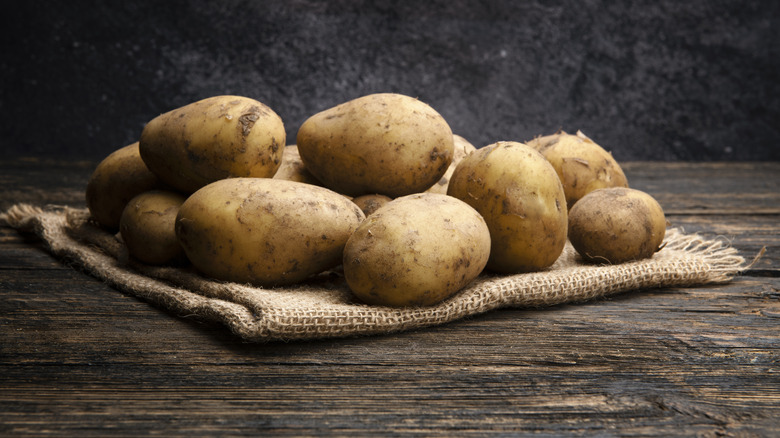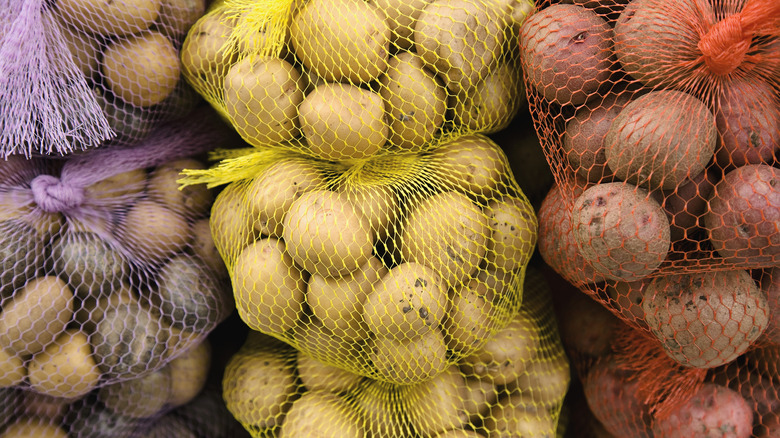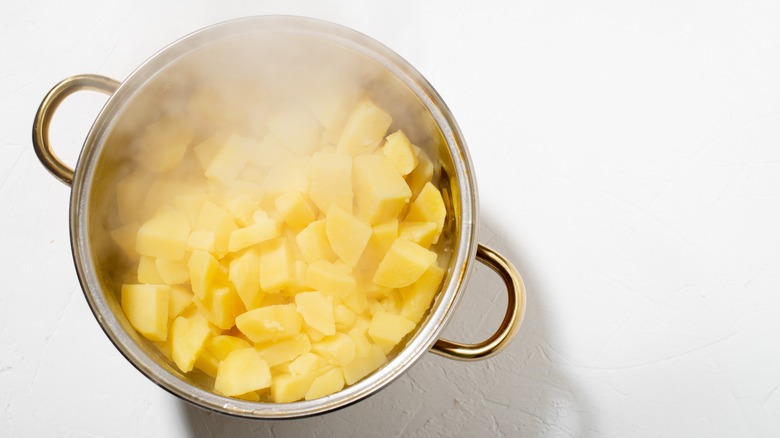Are Potatoes Classified As A Fruit Or Vegetable?
America's favorite vegetable isn't lettuce, carrots, or broccoli. It's potatoes. According to the USDA, Americans ate nearly 50 pounds of potatoes per capita in 2019, around 20 pounds more than the second most popular vegetable — the tomato. But hold up a minute — tomatoes are fruits, aren't they? Botanically speaking, fruits are the edible reproductive organs of plants, characterized by the seeds they bear, and yet tomatoes are legally considered vegetables. At a glance, the same inconsistency would also appear to be true of potatoes. After all, the eyes of potatoes are used to grow new plants, just as the seeds of fruits are. Did the U.S. government really reject biology twice in defining our favorite veggies? Thankfully not.
Potatoes are indeed vegetables. Their eyes are buds from which new stems sprout, but the actual seeds are contained in inedible berries that grow above ground. You might have heard potatoes referred to as root vegetables, but this isn't accurate either. Potatoes are actually underground stems known as tubers, and since any edible part of a plant other than its reproductive organs is considered a vegetable, including the stem, potatoes count as veg.
That's all true in the eyes of botanists, but nutritionists wouldn't be so quick to agree. Not all vegetables are created equal in terms of their nutritional content and culinary applications. Potatoes may be vegetables biologically, but in the kitchen, it's a different story.
Potatoes are a starchy vegetable
Vegetables can be broadly lumped into two groups: starchy and non-starchy. Most of the foods that we stereotypically think of as vegetables, such as lettuce, asparagus, and broccoli, are non-starchy vegetables. Beyond potatoes, starchy vegetables include yams, parsnips, and legumes. The difference between these classifications comes down to the carbohydrates they contain.
Carbohydrates are often demonized in discussions of health, but this is an oversimplification. Carbs are the body's primary source of energy, and along with fats and protein, they make up the three macronutrients essential for life. There are three types of carbohydrates: starch, fiber, and sugar. Vegetables contain mostly starch and fiber, and naturally, starchy vegetables are defined by their higher starch content.
Starchy vegetables also have a higher calorie content than non-starchy vegetables, which is one reason potatoes have become a food staple in so many cultures. They are jam-packed with energy, but this can be a double-edged sword. Most starchy vegetables have a low glycemic index, meaning that even though they raise your blood sugar, they do so at a slow, steady pace. Potatoes are the exception, with their high glycemic index raising concerns that they are bad for blood sugar. This is one of the main reasons many nutritionists argue potatoes should not be grouped with other vegetables.
Potatoes don't count towards your recommended vegetable intake
You may have heard about the "five a day" rule for vegetables. The American Heart Association recommends eating five servings of vegetables per day. Servings vary based on the type of vegetable, but the USDA MyPlate model suggests around 3 cups daily. It would be great if we could count a creamy side of mashed potatoes among those servings, but no such luck. It turns out that the potato's botanical classification as a vegetable holds little weight in the medical community.
Harvard nutritionist Lilian Cheung told CNBC that "a potato is not a vegetable from a nutrition point of view." The human body is able to process the starch in potatoes very quickly, much like it does with sugar. This causes a rapid spike in blood pressure comparable to some sodas and candies. Eating large quantities of potatoes is not recommended, particularly for diabetes patients.
Potatoes may not be the most popular food among nutritionists, but this view isn't universal. Some praise potatoes as good sources of vitamins, minerals, and fiber. They are especially rich in potassium, vitamin C, and vitamin B6. How you prepare potatoes has a significant impact on their nutritional value. Baking, roasting, or air-frying potatoes are great options. One of the biggest keys is eating potatoes with the skin on, which maximizes the amount of fiber you get. Ultimately, a moderate amount of potatoes is a perfectly fine addition to your diet.


